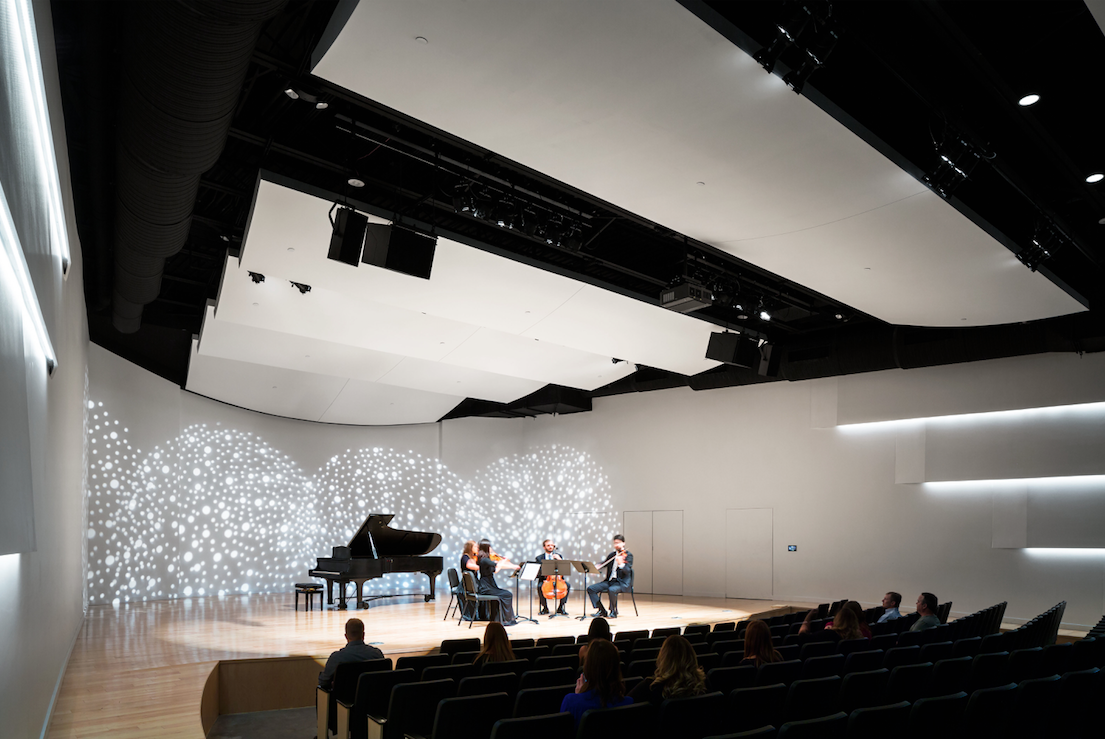A couple of years ago, Ruth Meints, Executive Director of the Omaha Conservatory of Music, got a notice from the organization’s landlord that the conservatory would have to vacate its space in a local community center by January 2016. Meints, who also teaches violin and viola at the OCM, wasn’t crazy about the space to begin with—it was small and had acoustical problems—but it was home. What to do?
Luckily, Meints happened to be in touch with David Lempke, HDR’s Vice President and Design Principal, and Lempke happened to be aware that Temple Israel had built a new facility in town, which freed up its old building as a possible home for the conservatory.
The old temple, built in 1952, was in decent shape, Lempke recalls. The conference room, administrative offices, and classrooms could be reprogrammed relatively easily for the conservatory’s needs for studios and teaching spaces. But the windows and roof needed to be replaced. Many of the walls lacked insulation or vapor barriers. The HVAC system had no humidity control—essential to protect the musical instruments—and would have to be replaced.
After $15 million in reconstruction, the new 40,000-sf conservatory opened in late 2015, well ahead of the deadline. The sanctuary, with its sloping floors and sidewalls, was converted to a shoebox-shaped performance center with a 48-foot-wide stage. Irwin Seating Company installed telescopic seats whose backs and bottoms fold up and retract, bleacher-style, into the back wall. This more than doubled the seating capacity to 500.
These days, Meints can lead her Violin Sprouts - the program she pioneered in 2013 for young musicians - under much improved conditions.
 After a devastating fire, Congregation Kehilath Jeshurum in New York reconsidered how to expand its sanctuary (pictured in its rebuilt state) and its school. Image: Chris Cooper.
After a devastating fire, Congregation Kehilath Jeshurum in New York reconsidered how to expand its sanctuary (pictured in its rebuilt state) and its school. Image: Chris Cooper.
OUT OF THE ASHES
Five years ago, FXFowle Architects was overseeing the renovation of Congregation Kehilath Jeshurun’s synagogue, in the Upper East Side of New York City, when the roof went up in flames. The fire severely damaged the century-old sanctuary but spared the lower school and the limestone neo-Classical façade. The fire prompted the institution to reconsider how to grow its facilities to meet the needs of its congregation and students.
Ann Rolland, FAIA, Principal with FXFowle, says that her firm recommended moving the 1,150-student school and gym to higher floors, which would more clearly delineate the functions of the building along its horizontal and vertical axes. That move required erecting a complicated structural system to support the two-story addition and relieve pressure on the synagogue’s walls during construction.
FXFowle brought the 18,000-sf sanctuary up to code. Italian crafts workers, using traditional methods, recreated columns, egg-and-dart molding, and new scagliola finishes on the main ark and new column enclosures. The steel reinforcement within the sanctuary had to be positioned to minimize seating loss for congregants.
This 80,000-sf project, which was completed in the summer of 2015, came in on budget at $40 million, says Rolland. ZDG LLC was the cost estimator; project management firm VVA was owner’s representative.
The synagogue’s worst fear—that its congregation would drift away during the reconstruction—proved to be unfounded. “This project was about rebuilding and revitalizing a community,” says Rolland.
Related Stories
| Aug 11, 2010
Giants 300 University Report
University construction spending is 13% higher than a year ago—mostly for residence halls and infrastructure on public campuses—and is expected to slip less than 5% over the next two years. However, the value of starts dropped about 10% in recent months and will not return to the 2007–08 peak for about two years.
| Aug 11, 2010
Bowing to Tradition
As the home to Harvard's Hasty Pudding Theatricals—the oldest theatrical company in the nation—12 Holyoke Street had its share of opening nights. In April 2002, however, the Faculty of Arts and Sciences decided the 1888 Georgian Revival building no longer met the needs of the company and hired Boston-based architect Leers Weinzapfel Associates to design a more contemporary facility.
| Aug 11, 2010
Team Tames Impossible Site
Rensselaer Polytechnic Institute, the nation's oldest technology university, has long prided itself on its state-of-the-art design and engineering curriculum. Several years ago, to call attention to its equally estimable media and performing arts programs, RPI commissioned British architect Sir Nicholas Grimshaw to design the Curtis R.
| Aug 11, 2010
Silver Award: Hanna Theatre, Cleveland, Ohio
Between February 1921 and November 1922 five theaters opened along a short stretch of Euclid Avenue in downtown Cleveland, all of them presenting silent movies, legitimate theater, and vaudeville. During the Great Depression, several of the theaters in the unofficial “Playhouse Square” converted to movie theaters, but they all fell into a death spiral after World War II.
| Aug 11, 2010
Biograph Theater
Located in Chicago's Lincoln Park neighborhood, Victory Gardens Theater Company has welcomed up-and-coming playwrights for 33 years. In 2004, the company expanded its campus with the purchase of the Biograph Theater for its new main stage. Built in 1914, the theater was one of the city's oldest remaining neighborhood movie houses, and it was part of Chicago's gangster lore: in 1934, John Dillin...
| Aug 11, 2010
Platinum Award: Reviving Oakland's Uptown Showstopper
The story of the Fox Oakland Theater is like that of so many movie palaces of the early 20th century. Built in 1928 based on a Middle Eastern-influenced design by architect Charles Peter Weeks and engineer William Peyton Day, the 3,400-seat cinema flourished until the mid-1960s, when the trend toward smaller multiplex theaters took its toll on the Fox Oakland.







